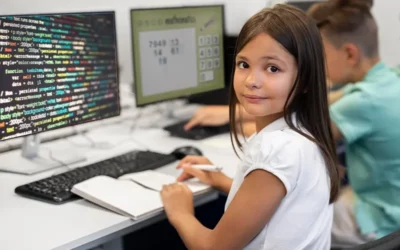Most people are struggling to achieve their financial goals, Do they ever check where their hard-earned money goes each month? The answer is no, because they don’t have proper financial management. Many people find financial management tricky. Mastering financial literacy is crucial in today’s world where every dollar matters. So, how can you gain control over your finances and ensure a prosperous future? That’s exactly what we will be covering in this blog, so make sure you read till the end!
Table of contents
Importance of Financial Literacy
Financial literacy isn’t just about knowing how to balance your checkbook; it’s about gaining the knowledge and skills to navigate the complex world of personal finance confidently. It empowers you to achieve financial security and pursue your life goals.
Goals of the Financial Literacy Project
Our goal is to equip you with the tools and knowledge you need to:
- Understand financial basics
- Make informed decisions about banking and financial products
- Build and maintain a solid credit score
- Manage day-to-day finances effectively
- Explore investment opportunities
- Navigate taxation wisely
- Avoid common financial pitfalls
- Teach financial literacy to children
- Use technology for better financial management
- Set and achieve SMART financial goals
- Stay informed in the digital age
Now, let’s dive into the heart of financial literacy.

Understanding Financial Basics
1. Budgeting for Beginners
The foundation of financial management is creating the budget. Start by tracking your income and expenses, and set realistic spending limits for each category. This simple step will help you control your finances and save for the future.
Moreover, Saving money is a habit that pays off in the long run. Learn about different saving strategies, like the 50/30/20 rule (50% necessities, 30% wants, 20% savings), to build your nest egg.
Also remember that life is unpredictable, and having an emergency fund is your financial safety net. Aim to save at least three to six months’ worth of living expenses in case of unexpected events.
Teaching budgeting for kids is also important, if they understand the concept at a younger age they can be a money management expert when they need to.
2. Debt Management Techniques
Effective debt management is a critical aspect of achieving financial stability. To successfully tackle your debts, it’s imperative to formulate a comprehensive plan.
Here’s a step-by-step breakdown of the debt management strategy:
- Identify Debts which have high interest: List all your outstanding debts, including credit cards, personal loans, and other financial obligations. Highlight those with the highest interest rates, as they are the ones eating away at your finances the fastest.
- Minimum Payments on Lower-Interest Debts: Make sure to pay at least the smallest amount required on your lower-interest debts when you are dealing with loans that have high interest rates. Through this way, you keep up with your financial promises and keep your credit score looking good.
- Allocate Extra Funds: Whenever you have additional funds available, allocate them toward paying off the high-interest debts. Even small extra payments can make a significant difference over time.
- Snowball Method: Consider using either the debt snowball method, depending on your preferences. The snowball method involves paying off the smallest debts first.
- Monitor Progress: Review regulerly your debt repayment plan to track your progress. Celebrate milestones as you pay off individual debts, as this can boost your motivation to continue.
- Seek Professional Advice: If your debt situation is particularly complex, don’t hesitate to seek advice from a financial advisor or credit counselor. They can provide tailored guidance to help you regain control of your finances.
Banking and Financial Products
1. Choosing the Right Bank Account and Credit Cards
When you select the bank account for you, always select the one which suits your needs. whether it’s a checking account for everyday expenses or a savings account for your goals. Look for low fees and consider online banks for convenience.
Also, credit cards can be helpful if used wisely. Pay your balance in full each month to avoid interest charges, and select cards with rewards that align with your spending habits.
2. Investing Wisely: Stocks vs. Bonds
Understanding Stocks and Bonds
- Stocks: Stocks, also known as equities, represent ownership in a company. When you buy stocks, you become a shareholder, which means you have a stake in the company’s profits and losses. Stocks are typically associated with higher risk and higher potential returns. Their value can fluctuate significantly over time based on various factors like company performance, market conditions, and economic trends.
- Bonds: Bonds, on the other hand, are debt securities. When you buy bonds, you are essentially lending money to a company or government entity in exchange for periodic interest payments and the return of the principal amount at the bond’s maturity. Bonds are considered more stable and less risky compared to stocks, making them a suitable choice for conservative investors.
The Importance of Diversification
- Diversification involves spreading your investments across different asset classes, such as stocks, bonds, real estate, and more.It is a fundamental principle in investment strategy. The goal of diversification is to reduce risk by not putting all your eggs in one basket. If one asset class underperforms, the strength of others can help offset potential losses.
- If the stock market experiences a downturn, the stability of bonds can save your portfolio from losses.On other hand, during bullish periods, the growth potential of stocks can enhance your overall returns. Balancing these two asset classes can provide a more stable and risk-managed investment portfolio.
Aligning with Long-Term Goals
- Your choice between stocks and bonds should align with your long-term financial objectives and risk tolerance. If you have a longer investment horizon, such as saving for retirement, you may consider a higher allocation to stocks, which historically have delivered better returns over extended periods.
- On the other hand, if you have short-term goals or a lower risk tolerance, a higher allocation to bonds can provide stability and capital preservation. It’s crucial to strike a balance that reflects your unique financial situation and goals.

Building a Solid Credit Score
Understand the factors that influence your credit score, such as payment history, credit utilization, and the length of your credit history. Also it’s important to manage your credit responsibly by paying bills on time, keeping credit card balances low, and avoiding opening too many new accounts. Steer clear of common credit blunders like maxing out credit cards or closing old accounts, which can negatively impact your credit score.
Managing Day-to-Day Finances
To gain control over your finances, start by tracking your daily expenses. Use apps or spreadsheets to monitor where your money goes. This will help you identify areas where you can cut back and save.
When grocery shopping, plan your meals in advance, make a list, and stick to it. Look for discounts, use coupons, and consider store brands to save on your grocery bill.
Embrace frugality by adopting a mindful spending approach. Differentiate between needs and wants, prioritize necessities, and find creative ways to enjoy life without overspending.
Investments and Wealth Building
Explore investment options like mutual funds, exchange-traded funds (ETFs), and retirement accounts. Diversify your portfolio to spread risk and increase the potential for returns.
Real estate can be a lucrative investment. Learn about rental properties, real estate investment trusts (REITs), and house flipping if you’re considering this avenue.
- Rental Properties: Owning rental properties can provide a steady stream of income. When you invest in rental properties, you can earn rental income from tenants, which can help cover your property expenses and potentially generate additional profit.
- Real Estate Investment Trusts (REITs): REITs are a convenient way to invest in real estate without owning physical properties. These trusts pool money from multiple investors to purchase and manage various types of real estate assets, such as residential or commercial properties, hotels, or shopping centers. Investing in REITs can offer diversification and regular dividend payments.
- House Flipping: If you have a knack for renovation and a good understanding of the housing market, house flipping can be a rewarding strategy. This involves buying properties that need improvements, renovating them, and selling them at a higher price.
Financial Pitfalls to Avoid
1. Recognizing Financial Red Flags
- Excessive Debt: One of the most significant financial red flags is excessive debt. This includes high credit card balances, personal loans, and outstanding bills that seem to pile up. When you find yourself struggling to keep up with debt payments, it’s a clear sign that your financial health may be in danger.
- Constant Overspending: Another warning sign is a pattern of constant overspending. If your expenses consistently exceed your income, it can lead to financial stress and may indicate a need to reassess your budgeting habits.
- Ignoring Bills: Ignoring bills or postponing payments can take you into a major financial problem. Late fees and penalties can accumulate, making it even more challenging to regain control of your finances. Addressing bills promptly is crucial to avoid long-term financial stress.
2. Common Financial Scams
- Online Scams: In the digital age, online financial scams are a prevalent threat. These scams can come in various forms, including phishing emails, fake websites, or fraudulent investment opportunities.
- Quick-Riches Offers: Be cautious of unsolicited offers that promise quick riches. If something sounds too good to be true, it often is. Scammers prey on individuals seeking fast financial gains, and falling for such schemes can result in significant financial losses.
3. Avoiding Impulse Purchases
- Shopping List: To avoid falling into the trap of consumerism, it’s wise to create a shopping list before going shopping, whether online or in-store. This list should include only items that you genuinely need.
- Consideration Time: Give yourself time to think before making a purchase. Impulse buying often occurs when decisions are rushed. By taking a moment to consider whether the item is a necessity or a desire, you can make more mindful and financially responsible choices.
Teaching Financial Literacy to Children
It’s always a question to parents when comes to financial education for their kids, how to teach kids about money. Its easy, and start teaching kids about money from a young age is must. Encourage saving, sharing, and responsible spending.
Tailor financial lessons to your child’s age and maturity level. For younger children, use piggy banks for kids and allowances. For older kids, open savings accounts and discuss budgeting.
It is essential to give financial literacy for kids to learn about financial management and tools. Kids’ most favourite online educational platform Brightchamps provides a program called Finchamp which helps to learn A-Z lessons of financial topics which helps your kids to understand about money and money management lessons. Join the revolution in education with Brightchamps.
Promote saving by matching your child’s savings, setting savings goals, and rewarding their financial achievements.
Conclusion
In conclusion, financial literacy is an essential skill that can significantly improve your financial well-being. By mastering the fundamentals of personal finance, making informed choices, and staying vigilant against common pitfalls, you can secure your financial future and achieve your goals.
Stay tuned for more insightful tips and guidance as we continue our Financial Literacy Project. Remember, financial success is within your reach!
To get your hands on more educational and free resources on coding for kids, robotics for kids, financial education for kids, etc., do check out the BrightCHAMPS Page now!
To get your hands on more such educational and free resources on coding, robotics, game development, etc., do check out the Brightchamps Blog Page now!
Frequently Asked Questions (FAQ’S)
A1. To get involved in a financial literacy project, start by researching local organizations or nonprofits focused on financial education. Reach out to them to inquire about volunteer opportunities or partnership possibilities. You can also consider starting your own project if you’re passionate about a specific aspect of financial literacy.
A2. When teaching children about money, tailor your lessons to their age and use real-life examples. Encourage saving, provide allowances, and be a good financial role model. Utilize age-appropriate books, games, and educational resources to make learning about money engaging.
A3. Reliable online financial literacy resources can be found on government websites, nonprofit organizations, educational websites, YouTube channels, podcasts, and online courses. Ensure the sources you choose are reputable and trustworthy.
A4. Yes, many governments have initiated financial education programs, including national strategies, educational materials, curriculum integration, awareness campaigns, and partnerships with organizations. Check your government’s official website or relevant regulatory authorities for specific initiatives in your country.
A5. Choosing a financial advisor involves researching qualifications, checking for fiduciary duty, interviewing potential advisors, understanding their fee structure, reading reviews, and trusting your instincts. It’s essential to select an advisor who aligns with your financial goals and values.


 We are an army of educators and passionate learners from BrightChamps family, committed to providing free learning resources to kids, parents & students.
We are an army of educators and passionate learners from BrightChamps family, committed to providing free learning resources to kids, parents & students.












